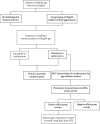Decreased Susceptibility of Shigella Isolates to Azithromycin in Children in Tehran, Iran
- PMID: 35386469
- PMCID: PMC8977332
- DOI: 10.1155/2022/4503964
Decreased Susceptibility of Shigella Isolates to Azithromycin in Children in Tehran, Iran
Erratum in
-
Corrigendum to "Decreased Susceptibility of Shigella Isolates to Azithromycin in Children in Tehran, Iran".Can J Infect Dis Med Microbiol. 2025 Jun 4;2025:9894508. doi: 10.1155/cjid/9894508. eCollection 2025. Can J Infect Dis Med Microbiol. 2025. PMID: 40689030 Free PMC article.
Abstract
Azithromycin (AZT) has widely been used for the treatment of shigellosis in children. Recent studies showed a high rate of decreased susceptibility to azithromycin due to different mechanisms of resistance in Shigella isolates. Accordingly, the purpose of this study was to investigate the role of azithromycin resistance mechanisms of Shigella isolates in Iran during a two-year period. In this study, we investigated the mechanisms of resistance among Shigella spp. that were isolated from children with shigellosis. The minimum inhibitory concentration (MIC) of Shigella isolates to azithromycin was determined by the agar dilution method in the presence and absence of Phe-Arg-β-naphthylamide inhibitor. The presence of 12 macrolide resistance genes was investigated for all isolates by PCR for the first time in Tehran province in Iran. Among the 120 Shigella spp., only the mph(A) gene (49.2%) was detected and other macrolide resistance genes were absent. The phenotypic activity of efflux pump was observed in 1.9% of isolates which were associated with over expression of both omp(A) and omp(W) genes. The high prevalence of the mph(A) gene among DSA isolates may indicate that azithromycin resistance has evolved as a result of antimicrobial selection pressures and inappropriate use of azithromycin.
Copyright © 2022 Parisa Behruznia et al.
Conflict of interest statement
The authors declare that there are no conflicts of interest.
Figures



Similar articles
-
Analysis of Neisseria gonorrhoeae susceptibility trends (MIC creep) from North India: A 15-years' experience!Indian J Dermatol Venereol Leprol. 2025 Jul-Aug;91(4):432-439. doi: 10.25259/IJDVL_1096_2024. Indian J Dermatol Venereol Leprol. 2025. PMID: 40357959
-
Prophylactic antibiotic therapy for chronic obstructive pulmonary disease (COPD).Cochrane Database Syst Rev. 2013 Nov 28;(11):CD009764. doi: 10.1002/14651858.CD009764.pub2. Cochrane Database Syst Rev. 2013. Update in: Cochrane Database Syst Rev. 2018 Oct 30;10:CD009764. doi: 10.1002/14651858.CD009764.pub3. PMID: 24288145 Updated.
-
Macrolide antibiotics (including azithromycin) for cystic fibrosis.Cochrane Database Syst Rev. 2024 Feb 27;2(2):CD002203. doi: 10.1002/14651858.CD002203.pub5. Cochrane Database Syst Rev. 2024. PMID: 38411248 Free PMC article.
-
Prophylactic antibiotics for adults with chronic obstructive pulmonary disease: a network meta-analysis.Cochrane Database Syst Rev. 2021 Jan 15;1(1):CD013198. doi: 10.1002/14651858.CD013198.pub2. Cochrane Database Syst Rev. 2021. PMID: 33448349 Free PMC article.
-
Signs and symptoms to determine if a patient presenting in primary care or hospital outpatient settings has COVID-19.Cochrane Database Syst Rev. 2022 May 20;5(5):CD013665. doi: 10.1002/14651858.CD013665.pub3. Cochrane Database Syst Rev. 2022. PMID: 35593186 Free PMC article.
Cited by
-
Prevalence of plasmid-mediated quinolone resistance genes and biofilm formation in different species of quinolone-resistant clinical Shigella isolates: a cross-sectional study.Eur J Med Res. 2024 Aug 14;29(1):419. doi: 10.1186/s40001-024-02007-y. Eur J Med Res. 2024. PMID: 39143645 Free PMC article.
-
Prevalence of Multidrug-Resistant and Extended-Spectrum Beta-Lactamase-Producing Shigella Species in Asia: A Systematic Review and Meta-Analysis.Antibiotics (Basel). 2022 Nov 18;11(11):1653. doi: 10.3390/antibiotics11111653. Antibiotics (Basel). 2022. PMID: 36421297 Free PMC article. Review.
-
The increasing antimicrobial resistance of Shigella species among Iranian pediatrics: a systematic review and meta-analysis.Pathog Glob Health. 2023 Oct;117(7):611-622. doi: 10.1080/20477724.2023.2179451. Epub 2023 Feb 16. Pathog Glob Health. 2023. PMID: 36794800 Free PMC article.
References
LinkOut - more resources
Full Text Sources
Miscellaneous

